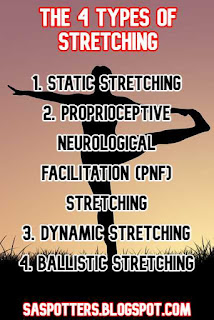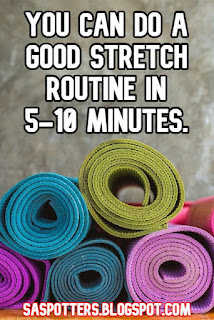This article is written by Rob Maxwell, M.A. Exercise Physiology, CSCS and ACSM CPT from www.fittothemax.net. Follow him on Twitter.
To stretch or not to stretch is the question.
We often talk about cardio-respiratory and strength exercise as the two kings of exercise. I do believe they are, but there is value to having flexibility.
Benefits of adding stretching to your workout plan
Having more flexibility can reduce the risk of injuries, help muscles recover from workouts and improve sports performance. A good stretching program doesn’t cost a lot of time and the return on the investment is great.
What is flexibility?
Let’s first talk about what flexibility is.
Flexibility is the degree to which a joint can go through a pain free range of motion. The more flexible (pliable) a particular muscle; is the more the joint can bend pain free.
Flexibility or stretching is not a warm-up
I want to establish this fact early on.
Using stretching as a warm-up might be the biggest myth in fitness. It’s right up there with doing crunches to flatten the stomach.
The worst time to stretch is prior to being warmed-up. The muscles should be warm when we are attempting to make them more pliable.
If we attempt to stretch a cold muscle, we can easily pull (tear) that muscle.
We see it all the time with kids (and sadly adults) and sports.
Coaches say, “Let’s warm up by stretching”. WRONG! Warm up and then stretch. A proper warm-up for stretching or anything else is light cardio-respiratory exercise.
The four types of flexibility or stretching
There are four types of flexibility. I focus on static stretching in this article because you can do it on your own and its intention is to improve flexibility. I want to briefly cover what all the types are.
The four types of flexibility are static, proprioceptive neurological facilitation (PNF), dynamic, and ballistic.
Static stretching
Static stretching is the stretching that you often think of. It is what I'm going to focus on today. It’s holding a steady stretch for 10-30 seconds.
Proprioceptive neurological facilitation (PNF) stretching
PNF stretching is done by contracting the muscle you want to stretch first (or that muscle's antagonist) and following that with a static stretch. This is a highly effective way to improve flexibility.
Dynamic stretching
Dynamic stretching is moving stretching. The word dynamic refers to movement. An example would be doing butt kicks like you may see runners doing.
It is moving the joint through as full of a range of motion as possible in a rhythmic manner. It is used often in sports as part of a warm-up after the muscles have been warmed up with light cardio.
It’s a highly effective warm-up, but it is not as effective for improving flexibility.
Ballistic stretching
Finally, there is ballistic stretching. This is stretching when you bounce from a standard static stretching position.
It really isn’t exercise at all. We still see people do this who are misinformed. This is not a recommended type of stretching and can lead to muscle pulls (tears).
When should you avoid stretching?
1. When you are hyper flexible in a specific joint
2. When you have an injury that needs to heal
Stretching correctly can enhance a person’s physical fitness. There are only a few occasions when it’s not recommended.
Stretching joints that are already too flexible can lead to muscular imbalances
Some people are already hyper flexible in certain joints. This is rare but it’s possible for someone who is predisposed to this or has spent time doing yoga or other disciplines.
You do not want to stretch more when you already hyper mobile. This could lead to excess muscle imbalances and injury. You would know if this was you so don’t worry about this unless you’ve had issues with this in the past.
Stretching can exacerbate damaged tissue
The second area that I caution against regarding telling people to stretch is when they have an injury. Injuries need to heal.
Stretch after the area has healed so that scar tissues won’t set in as much.
When you pull a muscle that is slang for a slight tear. Stretching a torn muscle will tear it more! If you think you have pulled a muscle, do not stretch it! Put ice on it!
Exercise prescription to improve flexibility
What muscles should you stretch?
The most common tight muscles are the hamstrings and hip flexors. Most people need lots of attention there.
I recommend stretching all of the major muscles of the body. It really doesn’t take long so there is little reason not to.
Stretch the thigh muscles such as the quadriceps and hamstrings. Stretch the hip muscles such as the glutes and the hip flexors. Stretch the lower leg muscles such as the gastrocnemius and soleus. Stretch the core muscle of the erector spinae (lower back) and abdominals. Stretch the upper torso muscles of the pecs, lats, and traps. Stretch the upper extremities muscles such as the deltoids and triceps.
When should you stretch?
There are two ideal times to stretch.
Stretch after workouts (strength or cardio) and stretch between sets of strength training exercises.
I stated above quite emphatically that you should never stretch prior to being warmed-up. The opposite is true.
Stretch after and during a workout. Sit on a mat and stretch all of your muscles after weight training.
Stretch when you are done before wrapping up your workout after running and other types of cardio.
Stretching your muscles after a workout can help your muscles to recover.
I love to stretch while I work out and I stretch between sets.
When I’m working a particular muscle group, I will stretch that area in between sets.
It’s a particularly effective use of rest time. I like to call it active rest.
This helps the muscles to recover and there is some research that indicates that it leads to better muscle growth.
How long should you stretch?
You should be able to stretch all of your major muscles in 5-10 minutes if you do a complete stretch session. You don’t have to move so quickly.
Stretching isn’t improved by doing more and more but if you are hyper mobile it also isn’t bad to stretch longer.
Most people run out of time and stretching is typically the one component that gets left out. For those people, remember that you can do it well in 5-10 minutes.
Another reason why I stretch during my workout is because I don’t have to spend the time to stretch afterwards.
Stretching is not improved by doing more and more of it.
Hold each stretch for 10-60 seconds. Sixty seconds per muscle group is highly effective. You can hold one stretch for sixty seconds or you can do multiple sets of 10 seconds. I like to do the latter.
I can get a better stretch by relaxing and starting again. When I’m stretching during my workouts, I hold the stretch for about 10 seconds. A little does go a long way.
How hard should you stretch?
The official rule is to only hold the stretch to the point of stretch. This means that you feel a pull, but you do not feel pain.
You will not benefit by stretching a muscle to the point of pain. Stretching improves with frequency.
If you are really concerned with your flexibility and want it better as soon as possible, you would be far better off to stretch multiple times per day than to stretch harder when you stretch.
Flexibility really improves with consistency.
I struggle with certain muscles staying pliable. I can forget to stretch for a couple of days and feel like I’m back to square one when I return to it. We really need to stay on top of our stretching.
Use the right form when you stretch
You don’t want to stretch improperly. Form is everything.
For each of the muscle groups I listed above, or if you wanted to just target your problem areas, go to YouTube and find different stretches. Make sure that the source is reputable.
Another great tool we use at our gym all the time is the classic Bob Anderson book 'Stretching'. It’s been around for decades and you can find any muscle group, sport, or problem and find stretches for them.
Final thoughts on flexibility
Stretching gets blown off quite a bit by fitness enthusiasts. I'm guilty of that myself at times.
I can attest to the fact that when I’m doing it consistently, I feel better and recover better. I also know that I move better when I’m more flexible.
The great Tom Brady is a big advocate of pliable and proper stretching. Look at him. He’s 43 and just won another Super Bowl!
I also like to make it meditative. When I stretch it’s like when I lift. I really visualize what I'm doing. If you turn it into a relaxing session like that, you may find that you are more likely to do it.
As I said above, I really like to use it as active rest during sets of strength training. It gives me enough time to rest between sets and improves my flexibility during the rest. That is a win/win.
If you realize that you don’t have to do as much as you may have been led to believe, you may find it a good thing to add to your routine. I hope you do because I see the value in it for me.
This article is written by Rob Maxwell, M.A. Exercise Physiology, CSCS and ACSM CPT from www.fittothemax.net. Follow him on Twitter.









No comments:
Post a Comment